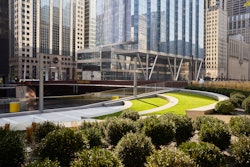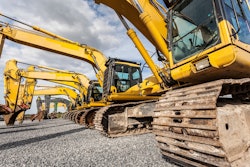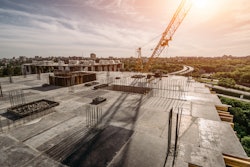
The overarching message of the United Nation's recent IPCC report was as clear as it was alarming: if we don’t immediately and drastically reduce our greenhouse gas emissions, we will face certain global catastrophe. The report called on every nation and industrial sector to lower their carbon footprints to the greatest extent possible, as soon as possible, to avoid raising the global temperature beyond 1.5° Celsius.
This message is of particular concern to the construction industry. Buildings and construction projects pump more carbon dioxide into the atmosphere than any other source – about 37% of global energy-related CO2 emissions
As daunting as the climate crisis is, it is not the only environmental challenge facing the construction industry that needs to be addressed. Beyond greenhouse gases, current construction methods contribute significantly to landfill waste, as well as other forms of pollution that are destructive to human health, natural ecosystems and quality of life.
We as an industry must innovate aggressively to avoid the worst outcomes of the climate crisis, as well as other natural catastrophes; in doing so, we will not only become vital partners in the global effort to stop global warming and build a healthier, sustainable world, but we will discover opportunities that will elevate the quality of our business and the built environments we create.
Nexii Building Solutions recently outlined its industry-leading sustainability and impacts metrics that we believe can serve as a model for the industry. This is a blueprint of initiatives that can transform the way the construction industry does business, both with individual company operations and across supplier and contractor networks. Among these key initiatives are:
Lowering the Industry’s Operational Carbon Emissions
Operational carbon refers to a building’s energy consumption and associated carbon emissions throughout its lifespan, attributed primarily to heating, cooling and ventilation (HVAC) systems. By focusing on insulated, airtight, energy efficient buildings powered by renewable energy, we can dramatically reduce a building’s total energy use and cost.
Reducing and eliminating the industry’s carbon pollution also includes identifying where companies generate pollution, and how they can operate differently. This could include upgrading all facilities to be more energy efficient, switching to renewable energy sources, using electric-powered vehicles and equipment, eliminating unnecessary business travel, and engaging supply-chain and green building technology partners with similar carbon reduction commitments. Using science-based targets evaluated by a third-party validator, such as SBTi, ensures high, consistent standards across the industry.
Lowering Embodied Carbon in Construction Materials
As we advance toward clean, renewable energy sources and create more efficient buildings that are operationally net-zero energy use, the embodied carbon in our building materials – emitted during extraction, manufacturing, assembly and end-of-life treatments – takes on an increasingly significant role. It is estimated that by 2050, embodied carbon will be responsible for nearly half of all new construction emissions. Nexii manufactures buildings and building products using a proprietary material, Nexiite, with up to 36% less embodied carbon than the conventional concrete used in precast and tilt-up concrete buildings. Other low-embodied carbon alternatives to steel, such as mass timber, are also gaining traction as building codes are updated to support their use. We must build on this momentum and continue developing and using decarbonized building materials, starting with innovative, low-carbon alternatives.
Eliminating Waste
Traditional construction produces an enormous amount of on-site waste and significantly impacts the surrounding environment’s land, air and water supply. In 2018, U.S. landfills were filled with nearly 145 million tons of waste from construction projects. As much as 30% of all construction materials delivered to a typical construction site can end up as waste. This waste can be cut down significantly – to nearly zero – by precision manufacturing of building products off-site and clean assembly on-site.
Facilities manufacturing buildings and building products can partner with third-party certification programs such as TRUE (Total Resource Use and Efficiency), administered by Green Business Certification Inc, which provides guidance on achieving zero waste goals, reducing carbon footprints and supporting a circular economy. This may include identifying reuse or recycling opportunities to divert waste landfill, right sizing bins and optimizing collection schedules, training staff around zero waste, and embedding goals into purchasing guidelines or policies.
Supporting Healthy Ecosystems
On average, people spend 80-90% of their lives indoors, where the concentration of pollutants can be two to five times higher than outdoors. Much of this can be attributed to the off-gassing of building materials that often contain toxic chemicals, and poorly designed ventilation. As we look to create and discover alternative building materials with lower embodied carbon, we must also ensure they don't contain toxic substances harmful to living creatures, humans and the environment. A high standard of transparency in this regard can be achieved by reporting building product ingredients in a standardized way, such as Healthy Product Declarations, Declare Labels and Cradle-to-Cradle certification.
Several initiatives aimed at minimizing embodied carbon in building products can also benefit healthy ecosystems, such as sourcing steel from plants that use electric arc furnaces versus blast furnaces. Steel produced using blast furnaces requires raw iron ore from mines that release sulfuric acid into the air and water supply, which damages plants, fish and other wildlife. Alternatively, steel produced using electric arc furnaces uses greater amounts of scrap and recycled steel and has significantly lower carbon emissions.
Reinventing How the World Builds
Over the past few decades, an intense focus on innovation in the design community has resulted in the development of net zero energy buildings that can be built anywhere in the world. However, scaling these solutions to meet the demands of the climate crisis won’t happen in a vacuum. It requires cooperation of mission-aligned companies to integrate technologies such as high-efficiency building envelopes, windows and HVAC systems, smart controls and on-site renewable energy into all types of buildings.
Nexii is integrating groundbreaking technologies that improve energy efficiency and reduce carbon emissions from industry leaders like Siemens, Trane Technologies, Pella, Rycom, Modern Niagara and Honeywell. Together, with Nexii’s proprietary materials and design process, these innovative technologies are key to delivering next generation buildings at scale.
Drive Low-Carbon Growth
Embracing green innovation must be an all-encompassing ethos within a company’s culture and the training and opportunities it provides to employees and other stakeholders. Developing robust green career pathways can be achieved through partnerships with local education communities to develop sustainability and Science, Technology, Engineering, Art/Design and Mathematics (STEAM) programs geared toward the construction industry. Creating internship programs that leverage the green business skills developed through these educational partnerships will build the foundation of a next-generation workforce for which low-carbon technologies and performance standards are second-nature. They will form the backbone of an innovation culture that will propel construction into an industry that builds a sustainable future rather than destroys it.








![Img 1791[100]](https://img.forconstructionpros.com/files/base/acbm/fcp/image/2022/09/IMG_1791_100_.632c76e4ca400.png?auto=format%2Ccompress&fit=crop&h=167&q=70&w=250)










